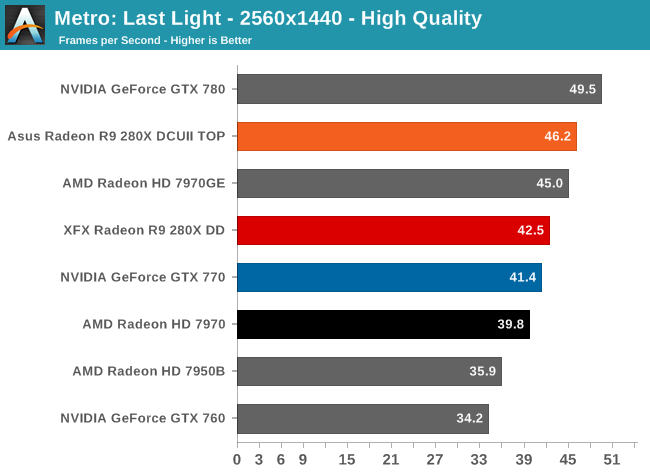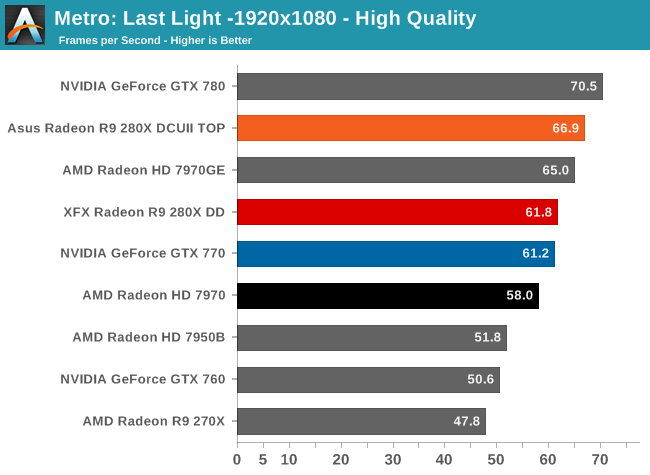The Radeon R9 280X Review: Feat. Asus & XFX - Meet The Radeon 200 Series
by Ryan Smith on October 8, 2013 12:01 AM ESTMetro: Last Light
Kicking off our look at performance is 4A Games’ latest entry in their Metro series of subterranean shooters, Metro: Last Light. The original Metro: 2033 was a graphically punishing game for its time and Metro: Last Light is in its own right too. On the other hand it scales well with resolution and quality settings, so it’s still playable on lower end hardware.



The first benchmark in our revised benchmark suite finds our 280X cards doing well for themselves, and surprisingly not all that far off from the final averages. Setting the baseline here, as we expected the Tahiti based 280X performs in between the original 7970 and 7970 GHz Edition, thanks to the 280X’s use of PowerTune Boost but at lower clockspeeds than the 7970GE. Consequently this isn’t performance we haven’t seen before, but it’s very much worth keeping in mind that the 7970GE was a $400 card while the 280X is a $300 card, so approaching the 7970GE for $100 less is something of a significant price cut for the performance.
As for the immediate competitive comparison, we’ll be paying particular attention to 2560x1440, which should be the sweet spot resolution for this card. At 2560 we can see that the reference clocked 280X doesn’t just hang with the $400 GTX 770 but actually manages to edge it out by just over a frame per second. As a preface we’re going to see these two cards go back and forth throughout our benchmarks, but to be able to directly compete with NVIDIA’s fastest GK104 card for $100 less is a significant accomplishment for AMD.
Finally, let’s quickly talk about the Asus 280X versus the XFX 280X. Asus winning comes as no great shock due to their factory overclock, but now we finally get to see the magnitude of the performance gains from that overclock. At 2560 we’re looking at just shy of a 9% performance gain, which is in excess of both the boost clock overclock and the memory overclock. The specific performance gains will of course depend in the game in question, but this means that the performance gains in at least one instance are being impacted by the base clock overclock, the larger of Asus’s factory overclocks.










151 Comments
View All Comments
Wreckage - Tuesday, October 8, 2013 - link
I did not see these on Newegg yet. Did AMD actually rebrand a card twice and paper launch it twice???Will Robinson - Tuesday, October 8, 2013 - link
That "rebrand" just kicked the crap out of NVDA's GTX770 for $100 less.Read it and weep.
Wreckage - Tuesday, October 8, 2013 - link
At least you can buy a 770 right now. I suppose you could print out a 280 and tape it to the side of your computer. Wake me when they can beat the GK110.rtsurfer - Tuesday, October 8, 2013 - link
If you had bothered to read the article you would have known that these cards are launching this week.Also,your beloved GK110 will be dealt with by R9 290X. I think you'll have to wait till October 15th for that news,as that is when the NDA expires.
colonelclaw - Tuesday, October 8, 2013 - link
Blimey, some people here are never happy. This card is basically a 770 but $100 cheaper. You know what that means? Nvidia will soon be dropping the price of the 770 and hopefully the 780 too - great news all round.Stop whining about 'rebadging' etc, the only thing that matters to 95% of gamers is the relationship between price and framerates.
Da W - Tuesday, October 8, 2013 - link
Precisely. I don't get fanboïsm. I'm gonna run 3600X1920 with full detail at an afordable price before christmas, be it with a 780 or a 290X. Of course 3 screens works better on AMD, i might be willing to pay a premium.gobaers - Tuesday, October 8, 2013 - link
Add a Z axis for power consumption / noise (two sides of the same coin). I'd take a small hit in framerate for a cooler or quieter card.stefstef - Tuesday, October 8, 2013 - link
looks like the 260 is going to replace the 7790 cards. now you get for the price the 7790 cards were introduced the 260. the 7790 prices dropped. now i wonder if i replace my 6670 for my 720p monitor with the rather cheap 7790 or get the new 260.Will Robinson - Tuesday, October 8, 2013 - link
R9 280X looks very good at $300....the improvements in noise and heat output are commendable.I'll be interested to see how it performs in BF4 after the Mantle API update.
It looks very strong in BF4 beta already.
http://techreport.com/review/25466/amd-radeon-r9-2...
nathanddrews - Tuesday, October 8, 2013 - link
Hmm, I think I'll wait for the next rebadge (re-rebadge) at 20nm. Maybe by summer they'll shrink and add the audio enhancements to the whole lineup. I'm happy for the MSRP price being $299, it should force the 7970GE to under that.If anything, I'm hoping that AMD's new lineup forces NVIDIA to stop overcharging for their products. I know that the market drives pricing, but if price scaled with performance, that means that the GTX700 should be $300 and the GTX780 should be about $350? Not that it will happen like that... but the 780 should not be over $400.